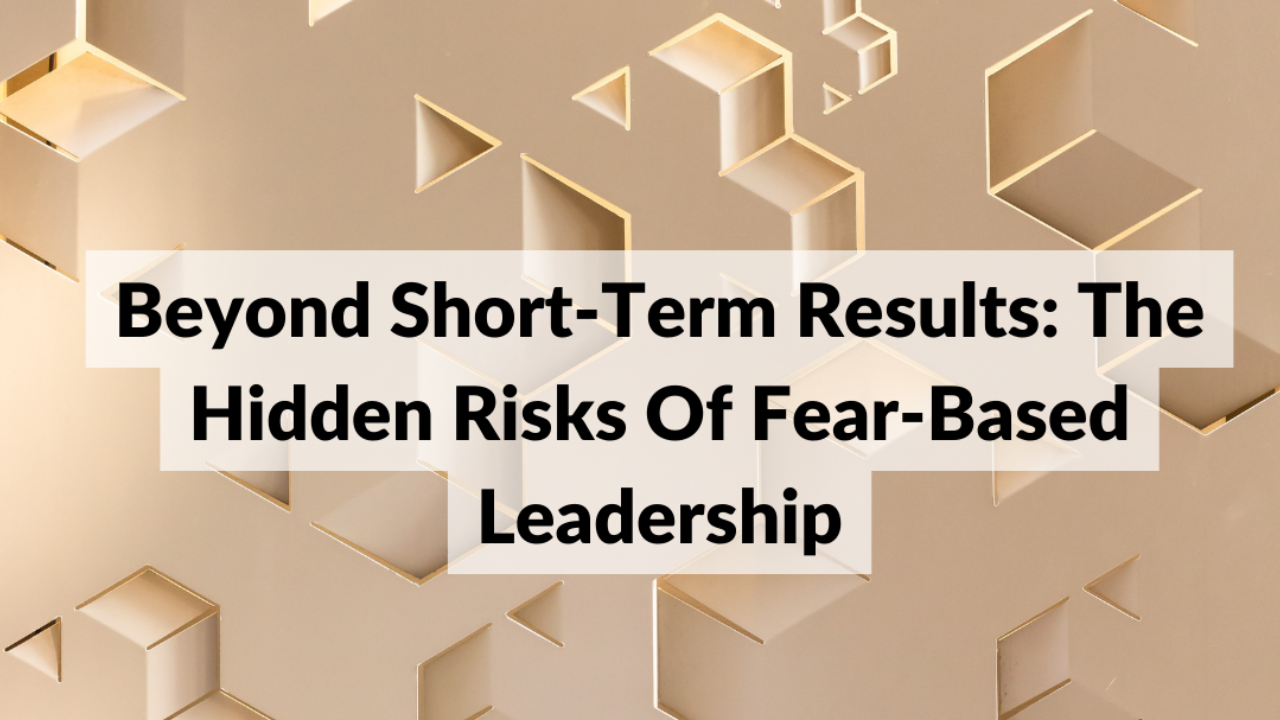Beyond Short-Term Results: The Hidden Risks Of Fear-Based Leadership
Jun 11, 2023
In a recent consult with one of my career-coaching clients, she explained to me that an abrupt change in leadership had occurred.
After reviewing her résumé and discussing at length her leadership readiness, I asked why she had become increasingly pessimistic and negative about being able to achieve this goal. The new leader who had been put into place within the past few weeks had begun to take a toll across the organization.
They came in “ready to shake things up” and made the following announcements:
• “I was hired to do a job; I have no loyalty to any of you.”
• “Your department is broken beyond repair. Why do we need it?”
• “There is a reorganization on the horizon; do what you feel with that information.”
• “Your role may remain, or may not. You will have to wait and see.”
• “Every day, log your tasks for the entire business unit to see.”
I was quite stunned to hear this. Immediately, it was obvious that the new leader was creating an environment filled with fear-based toxicity. Fear-based leadership is a style of leadership in which leaders rule with fear, coercion and punishment. Productive in their eyes, but difficult for team members.
The question I pose is, is this true leadership and is it sustainable? Let’s explore why some leaders operate this way and the impact this has on the team and organization as a whole.
What is the impact of fear-based leadership?
This leadership style can have several negative impacts on an organization, including:
1. Decreased employee morale: It can lead to a toxic work environment where employees are afraid to speak up or take risks. This can result in decreased morale, lower job satisfaction and higher turnover rates.
2. Reduced creativity and innovation: When employees are afraid to take risks and make mistakes, they are less likely to come up with new ideas and solutions, stifling creativity and innovation.
3. Lack of trust: When leaders rule by fear, employees may not trust them or feel that they have their best interests at heart. This can lead to a breakdown in communication and a lack of cooperation internally.
4. Increased stress and burnout: It creates a stressful work environment where employees are constantly worried about making mistakes or being punished, increasing levels of stress and burnout.
5. Negative impact on productivity: When employees are afraid to speak up or take risks, they may not be as productive as they could be, resulting in a culture of compliance rather than a culture of productivity and growth.
It is important for leaders to avoid using fear as a means of control and instead focus on building trust, promoting open communication and fostering a positive work environment.
Why do leaders lead with fear?
There are several factors that can contribute to someone adopting a fear-based leadership style:
1. Personality: Some individuals may have a personality that is more authoritarian or controlling. They may believe that fear and intimidation are necessary to maintain order and achieve goals.
2. Organizational culture: Fear-based leadership may be seen as the norm or even encouraged. Leaders may adopt this style in order to fit in or meet the expectations of their superiors.
3. Fear of failure: Leaders who are afraid of failure may resort to fear-based tactics to try to ensure that their team meets its goals.
4. Lack of trust: Leaders who do not trust their team may resort to fear-based tactics in order to maintain control via constant supervision and fear of punishment.
5. Insecurity: Leaders who are insecure in their own abilities may use fear-based tactics to maintain their position and authority to prevent others from questioning their decisions or challenging their leadership.
Fear-based leadership is not an effective or sustainable approach to leadership. While it may produce short-term results, it can lead to long-term negative consequences for the organization. Leaders who adopt a more positive, supportive leadership style are more likely to build a strong, successful organization in the long run.
What can you do if your manager is trying to coerce your efforts with fear?
1. Document: Keep a record of instances where the leader has used fear-based tactics: emails, messages or conversations where the leader has threatened or coerced the employee.
2. Talk to HR: If the behavior is severe or ongoing, speak to HR for guidance on how to handle the situation and possible intervention.
3. Address the behavior directly: If the behavior is less severe, you may want to address it directly with your leader, professionally and respectfully with a focus on the specific behavior and its impact on you and the team.
4. Seek support from colleagues: If other colleagues are experiencing similar behavior, you may want to seek support from them to validate your concerns.
5. Consider leaving: If the behavior is severe and ongoing, you may want to consider leaving the organization.
In this conversation, after much discussion, my client and I came to the same conclusion: It was time to sever ties.
The reality in this case was that she was being put through the ringer, weeks after the leader came into her role and with no sign of change. The mental, physical and emotional impact had begun taking a toll on multiple associates, and it was evident that this was who the new leader was, and changing people is not easy. Without direct internal support providing critical feedback to the new leader, the likelihood of change was minimal.
The organization will lose incredible talent as a result. It was our collective opinion that no job is worth enduring constant fear and intimidation.
If you find yourself on either side of this behavior, ask yourself if you are growing or benefiting the company in any way by remaining status quo.
Originally published for Forbes: https://www.forbes.com/sites/forbescoachescouncil/2023/05/26/beyond-short-term-results-the-hidden-risks-of-fear-based-leadership/?sh=6a7968cc60e2

